这个博客申请了有一段时间了,觉得好像是该写点什么了。这篇文章主要是关于一些xib的简单的用法,希望可以帮助到刚刚使用xib的新手们。
什么是xib? xib能做什么?
用来描述软件界面的文件。
如果没有xib,所有的界面都需要通过代码来手动创建。
有了xib以后,可以在xib中进行可视化开发,然后加载xib文件的时候,系统自动生成对应的代码来创建界面。
与xib类似的还有storyboard文件。xib和storyboard的比较,一个轻量级一个重量级。
共同点:
都用来描述软件界面。都用Interface Builder工具来编辑
不同点:
Xib是轻量级的,用来描述局部的UI界面
Storyboard是重量级的,用来描述整个软件的多个界面,并且能展示多个界面之间的跳转关系
二、xib的简单使用
1.建立xib文件
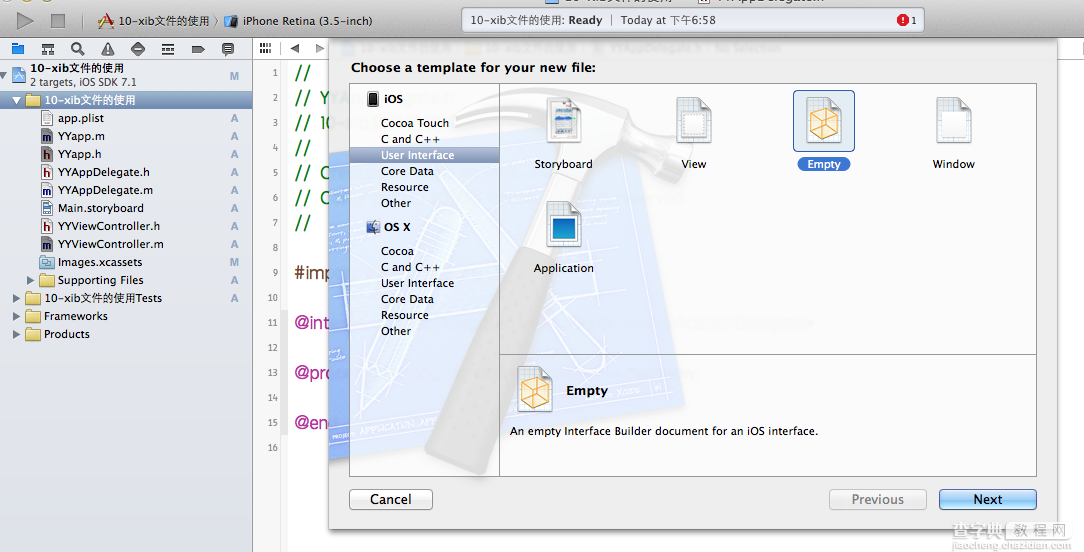
建立的xib文件命名为appxib.xib
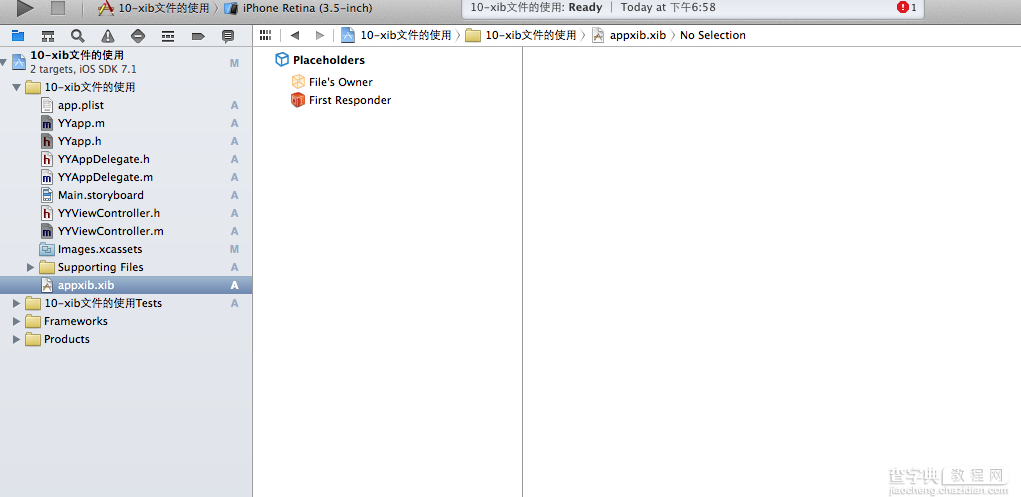
2.对xib进行设置
根据程序的需要,这里把view调整为自由布局
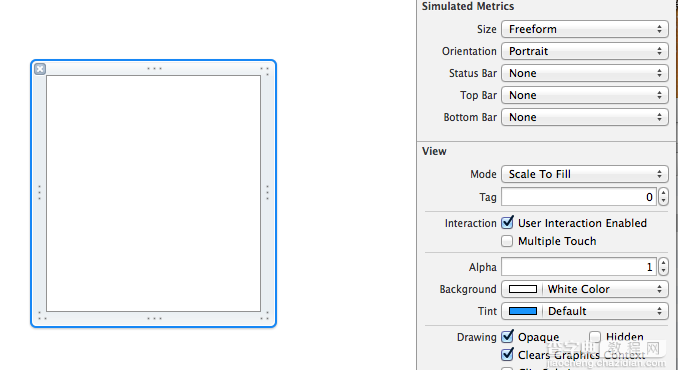
建立view模型(设置长宽等参数)

调整布局和内部的控件

完成后的单个view
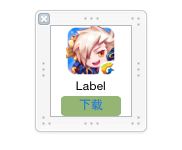
3.使用xib文件的代码示例
YYViewController.m文件代码如下:
// // YYViewController.m // 10-xib文件的使用 // // Created by apple on 14-5-24. // Copyright (c) 2014年 itcase. All rights reserved. // #import "YYViewController.h" #import "YYapp.h" @interface YYViewController () @property(nonatomic,strong)NSArray *app; @end @implementation YYViewController //1.加载数据信息 -(NSArray *)app { if (!_app) { NSString *path=[[NSBundle mainBundle]pathForResource:@"app.plist" ofType:nil]; NSArray *temparray=[NSArray arrayWithContentsOfFile:path]; //字典转模型 NSMutableArray *arrayM=[NSMutableArray array ]; for (NSDictionary *dict in temparray) { [arrayM addObject:[YYapp appWithDict:dict]]; } _app=arrayM; } return _app; } //创建界面原型 - (void)viewDidLoad { [super viewDidLoad]; NSLog(@"%d",self.app.count); //九宫格布局 int totalloc=3; CGFloat appviewW=80; CGFloat appviewH=90; CGFloat margin=(self.view.frame.size.width-totalloc*appviewW)/(totalloc+1); int count=self.app.count; for (int i=0; i<count; i++) { int row=i/totalloc; int loc=i%totalloc; CGFloat appviewX=margin + (margin +appviewW)*loc; CGFloat appviewY=margin + (margin +appviewH)*row; YYapp *app=self.app[i]; //拿出xib视图 NSArray *apparray= [[NSBundle mainBundle]loadNibNamed:@"appxib" owner:nil options:nil]; UIView *appview=[apparray firstObject]; //加载视图 appview.frame=CGRectMake(appviewX, appviewY, appviewW, appviewH); UIImageView *appviewImg=(UIImageView *)[appview viewWithTag:1]; appviewImg.image=app.image; UILabel *appviewlab=(UILabel *)[appview viewWithTag:2]; appviewlab.text=app.name; UIButton *appviewbtn=(UIButton *)[appview viewWithTag:3]; [appviewbtn addTarget:self action:@selector(appviewbtnClick:) forControlEvents:UIControlEventTouchUpInside]; appviewbtn.tag=i; [self.view addSubview:appview]; } } /**按钮的点击事件*/ -(void)appviewbtnClick:(UIButton *)btn { YYapp *apps=self.app[btn.tag]; UILabel *showlab=[[UILabel alloc]initWithFrame:CGRectMake(60, 450, 200, 20)]; [showlab setText:[NSString stringWithFormat: @"%@下载成功",apps.name]]; [showlab setBackgroundColor:[UIColor lightGrayColor]]; [self.view addSubview:showlab]; showlab.alpha=1.0; //简单的动画效果 [UIView animateWithDuration:2.0 animations:^{ showlab.alpha=0; } completion:^(BOOL finished) { [showlab removeFromSuperview]; }]; } @end
运行效果:
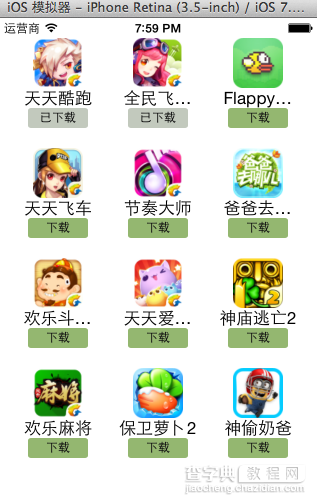
三、对xib进行连线示例
1.连线示例
新建一个xib对应的视图类,继承自Uiview
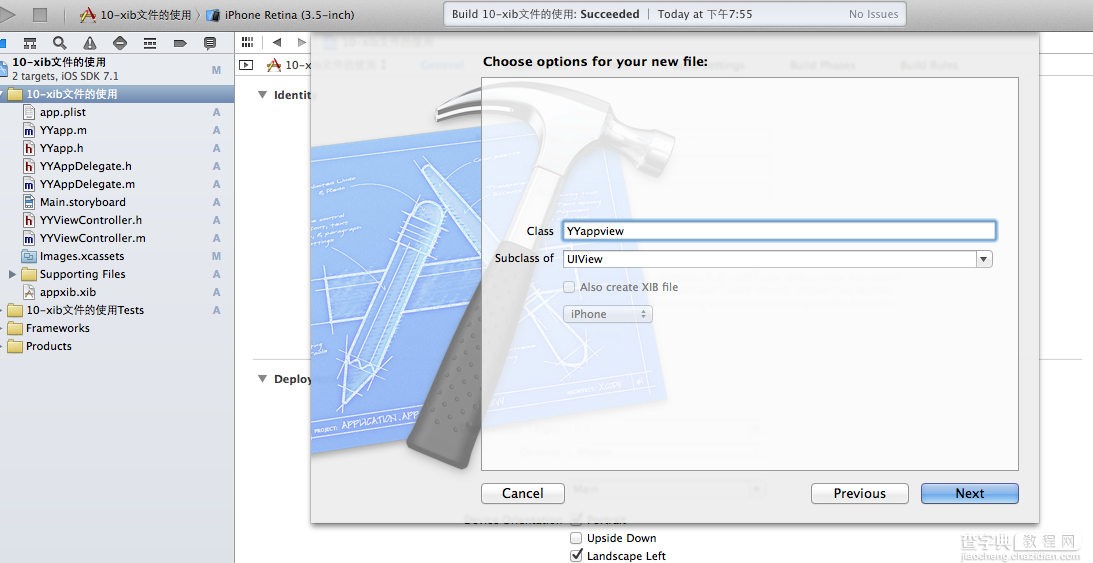
在xib界面右上角与新建的视图类进行关联
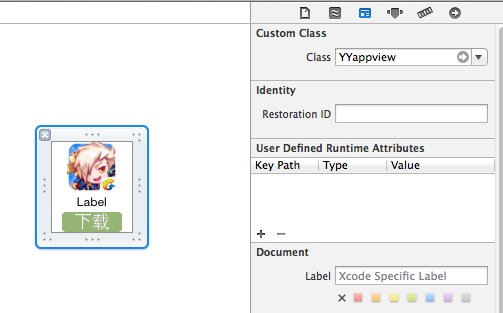
把xib和视图类进行连线
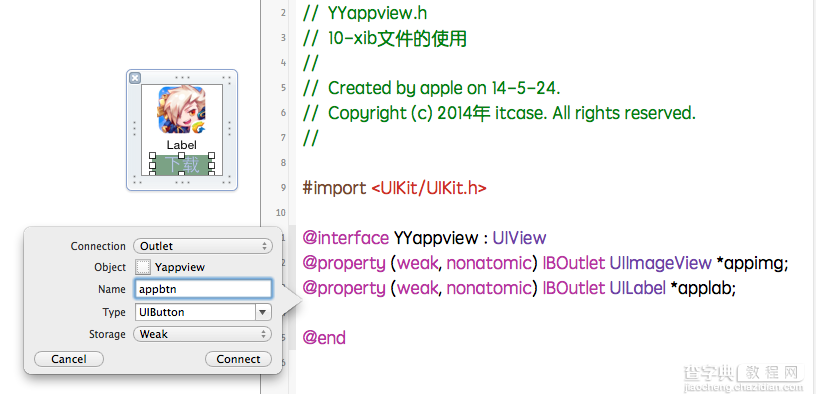
注意:在使用中把weak改成为强引用。否则...
2.连线后的代码示例
YYViewController.m文件代码如下:
// // YYViewController.m // 10-xib文件的使用 // // Created by apple on 14-5-24. // Copyright (c) 2014年 itcase. All rights reserved. // #import "YYViewController.h" #import "YYapp.h" #import "YYappview.h" @interface YYViewController () @property(nonatomic,strong)NSArray *app; @end @implementation YYViewController //1.加载数据信息 -(NSArray *)app { if (!_app) { NSString *path=[[NSBundle mainBundle]pathForResource:@"app.plist" ofType:nil]; NSArray *temparray=[NSArray arrayWithContentsOfFile:path]; //字典转模型 NSMutableArray *arrayM=[NSMutableArray array ]; for (NSDictionary *dict in temparray) { [arrayM addObject:[YYapp appWithDict:dict]]; } _app=arrayM; } return _app; } //创建界面原型 - (void)viewDidLoad { [super viewDidLoad]; NSLog(@"%d",self.app.count); //九宫格布局 int totalloc=3; CGFloat appviewW=80; CGFloat appviewH=90; CGFloat margin=(self.view.frame.size.width-totalloc*appviewW)/(totalloc+1); int count=self.app.count; for (int i=0; i<count; i++) { int row=i/totalloc; int loc=i%totalloc; CGFloat appviewX=margin + (margin +appviewW)*loc; CGFloat appviewY=margin + (margin +appviewH)*row; YYapp *app=self.app[i]; //拿出xib视图 NSArray *apparray= [[NSBundle mainBundle]loadNibNamed:@"appxib" owner:nil options:nil]; //注意这里的类型名! //UIView *appview=[apparray firstObject]; YYappview *appview=[apparray firstObject]; //加载视图 appview.frame=CGRectMake(appviewX, appviewY, appviewW, appviewH); [self.view addSubview:appview]; appview.appimg.image=app.image; appview.applab.text=app.name; appview.appbtn.tag=i; [ appview.appbtn addTarget:self action:@selector(appviewbtnClick:) forControlEvents:UIControlEventTouchUpInside]; } } /**按钮的点击事件*/ -(void)appviewbtnClick:(UIButton *)btn { YYapp *apps=self.app[btn.tag]; UILabel *showlab=[[UILabel alloc]initWithFrame:CGRectMake(60, 450, 200, 20)]; [showlab setText:[NSString stringWithFormat: @"%@下载成功",apps.name]]; [showlab setBackgroundColor:[UIColor lightGrayColor]]; [self.view addSubview:showlab]; showlab.alpha=1.0; //简单的动画效果 [UIView animateWithDuration:2.0 animations:^{ showlab.alpha=0; } completion:^(BOOL finished) { [showlab removeFromSuperview]; }]; } @end
YYappview.h文件代码(已经连线)
#import <UIKit/UIKit.h> @interface YYappview : UIView @property (strong, nonatomic) IBOutlet UIImageView *appimg; @property (strong, nonatomic) IBOutlet UILabel *applab; @property (strong, nonatomic) IBOutlet UIButton *appbtn; @end
以上就是本文的全部内容,希望对大家的学习有所帮助,也希望大家多多支持查字典教程网。
【iOS开发UI篇—xib的简单使用实例】相关文章:
